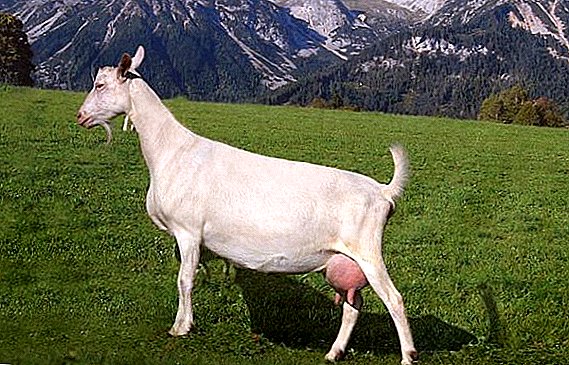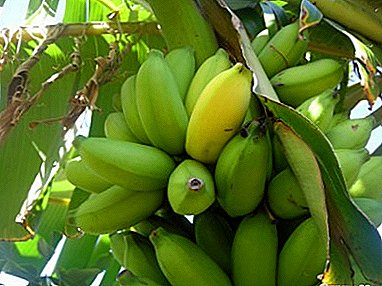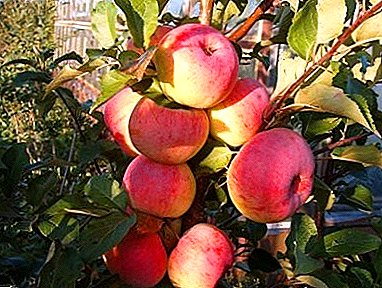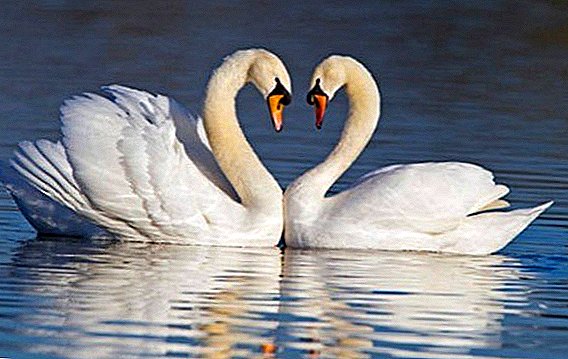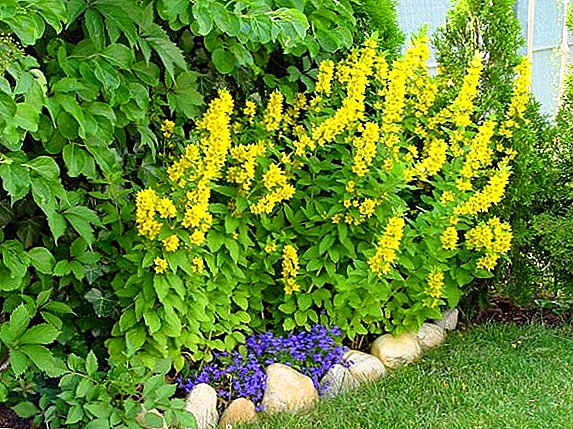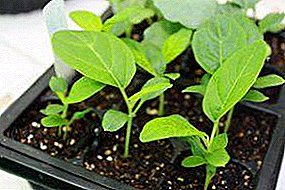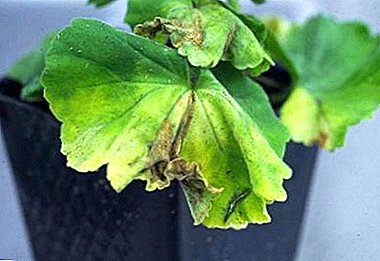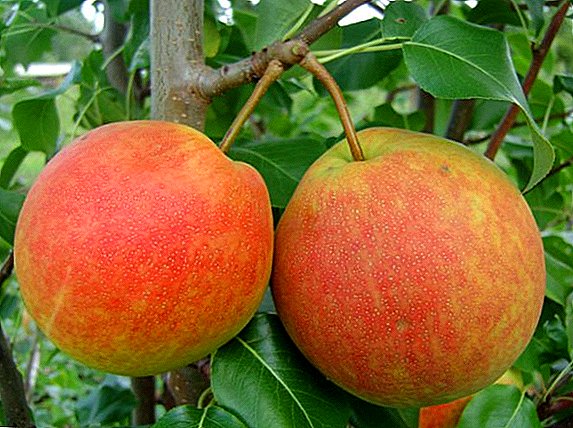 Pear is, perhaps, the second most popular fruit tree after an apple tree, which is grown by professional gardeners and amateur gardeners in the vast expanses of Russia and the states that were previously part of the USSR. The tree became so widespread due to a combination of two factors - the ability to endure rather harsh conditions of both the middle zone and more northern areas (especially for specially bred frost-resistant varieties), as well as the taste and unforgettable aroma of pear fruits, which, in addition and perfectly preserved, easily processed and can be used not only as a base for desserts and drinks, but also as indispensable ingredients for a wide variety of basic dishes, soups and snacks.
Pear is, perhaps, the second most popular fruit tree after an apple tree, which is grown by professional gardeners and amateur gardeners in the vast expanses of Russia and the states that were previously part of the USSR. The tree became so widespread due to a combination of two factors - the ability to endure rather harsh conditions of both the middle zone and more northern areas (especially for specially bred frost-resistant varieties), as well as the taste and unforgettable aroma of pear fruits, which, in addition and perfectly preserved, easily processed and can be used not only as a base for desserts and drinks, but also as indispensable ingredients for a wide variety of basic dishes, soups and snacks.
Did you know? The ancient Greeks used pears to treat motion sickness and other forms of nausea, and they treated the fetus with such piety that they even sacrificed it to two most revered goddesses, Gena and Aphrodite.
Depending on when the pears are harvested, these trees are divided into summer, autumn and winter. Maturity pear "Otradnenskaya", which will be discussed below, falls in September, which means that this pear belongs to the autumn varieties.
History of creating varieties of pears "Otradnenskaya"
 Pear "Otradnenskaya" was withdrawn at the Moscow Agricultural Academy. KA Timiryazev. Breeders S.T. Chizhov and S.P. Potapov, the authors of a huge number of equally popular hybrid varieties of pears (for example, Rogneda, Moskvichka, and others), received it as a result of the hybridization of the Forest Beauty and the not so well-known varieties of pears Theme. In 2000, this variety was included in the State Register of Breeding Achievements of the Russian Federation in the North-West, East-Siberian and Central Black Earth regions.
Pear "Otradnenskaya" was withdrawn at the Moscow Agricultural Academy. KA Timiryazev. Breeders S.T. Chizhov and S.P. Potapov, the authors of a huge number of equally popular hybrid varieties of pears (for example, Rogneda, Moskvichka, and others), received it as a result of the hybridization of the Forest Beauty and the not so well-known varieties of pears Theme. In 2000, this variety was included in the State Register of Breeding Achievements of the Russian Federation in the North-West, East-Siberian and Central Black Earth regions.
Characteristics and characteristics of the variety
Pear "Otradnenskaya" has an official assessment: appearance - 4 points, fruits - 3.7-4 points. The main advantages of the variety are high resistance to diseases, especially scab, precociousness, and cold resistance. Despite the fact that the tree is self-fertile, it shows a much higher fruiting during perefilming. Such pollinators as “Favorite Yakovlev” and “Chizhovskaya” showed themselves as pollinators.
Tree description
 The height of the Otradnenskaya pear tree is average. The crown of young trees is similar to a funnel, although with age it becomes round or oval, of irregular shape. It is not too thick, but has many small dark green leaves on the branches. The tree type is standard, the bark of the trunk and skeletal branches is colored dark gray (the branches are lighter). Skeletal branches with a trunk make an acute angle, because of which they can break off at the time of ripening. The tree has thin, curved, medium length shoots of brown color. The frequency of ejection of shoots is low. Dark brown buds, on the contrary, awake perfectly, and in shape they look like a cone, slightly deviated from the branch.
The height of the Otradnenskaya pear tree is average. The crown of young trees is similar to a funnel, although with age it becomes round or oval, of irregular shape. It is not too thick, but has many small dark green leaves on the branches. The tree type is standard, the bark of the trunk and skeletal branches is colored dark gray (the branches are lighter). Skeletal branches with a trunk make an acute angle, because of which they can break off at the time of ripening. The tree has thin, curved, medium length shoots of brown color. The frequency of ejection of shoots is low. Dark brown buds, on the contrary, awake perfectly, and in shape they look like a cone, slightly deviated from the branch.
The leaves have the shape of an elongated and slightly curved oval with jagged edges and a long petiole. They are thin, elastic and smooth to the touch. The inflorescences are a brush of 5-7 white buds, and later - medium-sized flowers in the form of cups with petals growing together at the edges. Fruits of the pear "Otradnenskaya" are tied mainly on young short shoots and short branches.
Fruit Description
 The described pear begins to bear fruit at the age of four to five years. The mass of pears of the variety "Otradnenskaya" does not exceed 150 g, so that they do not create problems associated with premature fall. Fruits have a rounded or linguoconical shape, the color is yellow-green with a red side. After harvesting, the pears ripen, changing to a more saturated yellow with pronounced redness. Tastes of fruits are high enough, the flesh is thick and sweet, while the fruit bearing tree is stable, and the yield of pear "Otradnenskaya" exceeds the average in appearance.
The described pear begins to bear fruit at the age of four to five years. The mass of pears of the variety "Otradnenskaya" does not exceed 150 g, so that they do not create problems associated with premature fall. Fruits have a rounded or linguoconical shape, the color is yellow-green with a red side. After harvesting, the pears ripen, changing to a more saturated yellow with pronounced redness. Tastes of fruits are high enough, the flesh is thick and sweet, while the fruit bearing tree is stable, and the yield of pear "Otradnenskaya" exceeds the average in appearance.
Many gardeners dislike this variety because of not too high juiciness. In addition, these fruits have a poorly pronounced pear flavor, although the taste has not less admirers: the loose fruit falling apart in the mouth does not please everyone. Relative hardness provides good transportability of Otradnenskaya pear.
Some nuances of planting seedlings pear varieties "Otradnenskaya"
When is it better to plant
Planting pear varieties "Otradnenskaya" can be carried out both in spring and autumn, and as for the seedlings grown in containers, they are planted in any warm season. However, it should be borne in mind that when planting in the autumn period there is the likelihood of slow development of the tree. In this regard, most gardeners recommend still planting a pear in the spring, even if the seedling is purchased in the fall.
In the latter case, it is just lightly dropped in a shallow hole, so that the young tree is tilted to the ground at a sharp angle. The roots of the seedling should be well covered with leaves, agrofibre, straw, sawdust or other material that is available. In the spring, such a sapling is carefully dug, inspected for any damage (they should be removed) and planted in a prepared place.
Where better to plant
 Agrotechnics pear "Otradnenskaya" necessarily includes the correct choice of a place for planting a tree, because not only its health and longevity, but also the quantity and quality of the fruits with which it will please you depends on it. In spite of the fact that the considered variety does not differ by too active development and growth, it is better to choose a place for the tree where it will not be oppressed by its neighbors. It is also important to have good lighting and fresh air that will blow the plant.
Agrotechnics pear "Otradnenskaya" necessarily includes the correct choice of a place for planting a tree, because not only its health and longevity, but also the quantity and quality of the fruits with which it will please you depends on it. In spite of the fact that the considered variety does not differ by too active development and growth, it is better to choose a place for the tree where it will not be oppressed by its neighbors. It is also important to have good lighting and fresh air that will blow the plant.
Important! It is a mistake to limit the space around a young pear with various structures, fences or other trees, as in this case the sapling will not be able to form the correct crown, will begin to uncontrollably reach for the sun, which will adversely affect the fruiting function.
The described pear is not very demanding to the soil composition, but if the soil is too depleted, before planting it should be enriched with additives useful for the plant.
Stepwise landing process
For planting pears "Otradnenskaya" choose a young sapling. A tree older than two years may not settle down, and with an increase in the age of the pear, the chances of a successful transplant decrease. After the seedling and the place for the pear are chosen, it is necessary to dig a hole about 0.8 m in diameter and 1 m deep. If you plan to plant several trees, the distance between them should be at least three meters.
 The topsoil of the soil is separated and mixed with organic and mineral fertilizers. (humus - 10 l, superphosphate - 0.25 l, potash salts - 0.15 l, wood ash - 3-4 press). Next, at the bottom of the pit, it is necessary to build a small cone-shaped mound of fertile soil, slightly tamp it down and place the seedling on top so that its roots flow around this artificial cone.
The topsoil of the soil is separated and mixed with organic and mineral fertilizers. (humus - 10 l, superphosphate - 0.25 l, potash salts - 0.15 l, wood ash - 3-4 press). Next, at the bottom of the pit, it is necessary to build a small cone-shaped mound of fertile soil, slightly tamp it down and place the seedling on top so that its roots flow around this artificial cone.
Then you need to gently sprinkle the pit with a prepared fertile mixture, leaving the root neck a few centimeters above the surface. This is necessary so that it does not end up underground after watering, when the ground will settle a little.
Important! It is necessary to bury the pit so that inside did not remain air interlayers, otherwise the roots of the tree will begin to rot, and the pear will die.
When you dig a hole in the hole, protect the near-stem circle so that the water lingers inside it. For the formation of such a fence you can use the barren soil, previously dug out of the pit for planting seedlings. Then, the planted tree should be plentifully watered and tied up to a peg hammered alongside to protect it from strong wind gusts. The peg must be buried in the ground so that it does not come into contact with the seedling and does not damage its root system.
Some tips on caring for pear "Otradnenskaya"
Caring for pears "Otradnenskaya" is not particularly difficult and not too different from the care of other varieties of pears. However, in this process there are still certain nuances that should be considered for a novice gardener.
Treating and protecting pears from pests and diseases
Pear "Otradnenskaya" was derived as an unpretentious variety, so the tree is quite stable against diseases and pests, although regular preventive measures cannot be ruled out.
 In the spring, even before the plant has formed a kidney, it should be sprayed to avoid subsequent infection. A ten percent ammonia solution is well suited for this purpose, since it effectively removes both a variety of pests and fungal and bacterial disease carriers. Immediately before flowering and immediately after it, the pear is sprayed twice with insecticidal preparations in order to protect it from ticks, tsternbears and moths. Actually, wood processing ends here. However, it should be remembered that pests and diseases affect primarily neglected trees, settling in peeled bark, fruits that have rotted or uncollected from under the tree, etc.
In the spring, even before the plant has formed a kidney, it should be sprayed to avoid subsequent infection. A ten percent ammonia solution is well suited for this purpose, since it effectively removes both a variety of pests and fungal and bacterial disease carriers. Immediately before flowering and immediately after it, the pear is sprayed twice with insecticidal preparations in order to protect it from ticks, tsternbears and moths. Actually, wood processing ends here. However, it should be remembered that pests and diseases affect primarily neglected trees, settling in peeled bark, fruits that have rotted or uncollected from under the tree, etc.
Therefore, the best way to combat diseases and pests is to clean the bark and tree trunks from debris, weeds, rotten fruits, mosses and lichens. Dead bark should always be scraped off, and bare areas should be treated with a 3% solution of ferrous sulfate. This procedure is carried out in early spring.
If leaves or ovaries affected by a pest are found on the tree - they must be immediately removed and burned, then there is a chance to get rid of the problem at an early stage. When the fruits begin to form, the grass inside the circle of the trunk should not weed, but to mow, but the soil should not be dug up. As a preventive measure, it is recommended to whiten a pear with a mixture of clay and lime in a 1: 1 ratio. Iron sulfate (0.1 kg per 10 l) is also added to the resulting solution.
How to conduct watering
 In the first year after planting, the plant requires constant monitoring, but it should be watered as needed. After watering, in order to avoid evaporation of moisture, the soil should be loosened. Digging pristvolnyh circles (before fruiting) allows moisture to penetrate better into the soil. The pear does not tolerate overmoistening; therefore, it is enough to water an adult tree once a month, and even less often in rainy weather.
In the first year after planting, the plant requires constant monitoring, but it should be watered as needed. After watering, in order to avoid evaporation of moisture, the soil should be loosened. Digging pristvolnyh circles (before fruiting) allows moisture to penetrate better into the soil. The pear does not tolerate overmoistening; therefore, it is enough to water an adult tree once a month, and even less often in rainy weather.
What and when to feed
Feeding pears "Otradnenskaya" should be carried out regularly. Then the tree will receive good nutrition and bring a good harvest. In the fall, top dressing is necessary for the plant to form better wood and, thus, easier to endure frosts. For this purpose, it is necessary to use potash and phosphate fertilizers.
 Nitrogen is not needed in this period of the season, as it promotes the active growth of young shoots, totally inappropriate on the eve of winter. Mineral fertilizers are buried around the perimeter of the trunk circle to a depth of about 20 cm, then they are watered and sprinkled with a dry layer of soil. Spring dressing allows the tree to more easily get out of the state of winter dormancy and enter the vegetation phase.
Nitrogen is not needed in this period of the season, as it promotes the active growth of young shoots, totally inappropriate on the eve of winter. Mineral fertilizers are buried around the perimeter of the trunk circle to a depth of about 20 cm, then they are watered and sprinkled with a dry layer of soil. Spring dressing allows the tree to more easily get out of the state of winter dormancy and enter the vegetation phase.
At this time, pear needed organic and mineral (including nitrogen) fertilizers. Additional feeding, if desired, can be done at the beginning of summer, which will enrich the tree with nutrients and improve the quality of the fruit.
How to conduct pruning
Immediately after planting, a young annual seedling is formed so that its height does not exceed 1 m, and all the buds located on the lower half of the young tree should also be removed. The following year, the procedure is repeated. If the seedling is two years old, then after planting it is still cut, though not so radically (about 1/3 of the height). Pruning is necessary for the plant to stimulate the development of the root system.
 In the future, the pear should be allowed to independently form the crown, unnecessary intervention can only harm the tree. As soon as the pear reaches the fruiting age (this can occur at the age of 3-4 years), sanitary pruning of the tree is carried out, at which mainly diseased and damaged branches are removed.
In the future, the pear should be allowed to independently form the crown, unnecessary intervention can only harm the tree. As soon as the pear reaches the fruiting age (this can occur at the age of 3-4 years), sanitary pruning of the tree is carried out, at which mainly diseased and damaged branches are removed.
Pruning of old trees is necessary for their rejuvenation. To do this, cut the tip, and then thinning is done: first of all, dried, old and non-bearing branches are cut. In addition, shoots are cut that grow parallel to the trunk or at a too acute angle to it (they tend to break under the weight of the fruit). The remaining branches can be shortened by ¼ of their length.
Did you know? The pear should not be cut in cold weather, the tree tolerates such a procedure very badly. Pruning can be done in the fall, not later than September, or in the spring, when the air and the soil are warm enough.
The time of ripening and storage of fruits of pear varieties "Otradnenskaya"
 Fruits pear "Otradnenskaya" ripen in late September and at this time they can already be removed. However, to purchase a full-bodied flavor taste of a pear, it needs to ripen another 2-3 weeks after harvest. In general, the pears of the described varieties are kept for a short time, at best, until the New Year, and provided that the fruits are laid out in bags and are in a cool place. In a warm room, pears are saved much less time and quickly deteriorate.
Fruits pear "Otradnenskaya" ripen in late September and at this time they can already be removed. However, to purchase a full-bodied flavor taste of a pear, it needs to ripen another 2-3 weeks after harvest. In general, the pears of the described varieties are kept for a short time, at best, until the New Year, and provided that the fruits are laid out in bags and are in a cool place. In a warm room, pears are saved much less time and quickly deteriorate.
The fragility of storing pears "Otradnenskaya" perfectly compensated by numerous ways of its processing and harvesting. Juices, jams, jams, compotes are often made from fruits, they can also be dried or frozen, and home-made wines and stronger drinks made from pear are a separate pride of summer residents.
Preparing young pear trees for winter
Pear "Otradnenskaya" has a rather high resistance to harsh winters, so the main procedure required for the tree in preparation for winter is the harvesting of opal foliage and mummified fruits with their subsequent burning. Since the scab practically does not damage this pear variety, the usual preventive spraying of other pears can be avoided.  However, young seedlings are often less prepared for severe frost than an adult tree, so you need to take extra care of them. After a hot summer, the soil should be well moistened, since, being in dry ground, the plant tolerates much more cold. Further, the roots of a tree can be warmed with fallen leaves or other improvised material (but not only with straw, since it is a favorite place for the mice that freeze in winter).
However, young seedlings are often less prepared for severe frost than an adult tree, so you need to take extra care of them. After a hot summer, the soil should be well moistened, since, being in dry ground, the plant tolerates much more cold. Further, the roots of a tree can be warmed with fallen leaves or other improvised material (but not only with straw, since it is a favorite place for the mice that freeze in winter).
In order to protect against mice and other rodents, who chew on the bark of a young seedling with pleasure, it must be carefully wrapped with a sacking cloth or net. If in the spring it turns out that the pear is still slightly frozen over, the shoots of replacement should be strengthened in a horizontal position (tied up or supported), otherwise ovaries will not form on them.
In general, we can say that pear varieties "Otradnenskaya" It is an excellent choice for those who love not too soft fruits, live in not very favorable climatic conditions and are not ready to mess with pampered and capricious fruit trees.


